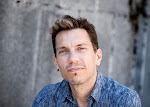Steppenwolf, on at the Russian Hall in Strathcona through this afternoon as part of the PuSh Festival, is the debut production of Fight with a Stick, a new local company formed by my SFU colleague and former Leaky Heaven artistic director Steven Hill and veteran theatre artist Alex Lazaridis Ferguson. The work is an adaptation of Herman Hesse's 1927 novel of the same name, about a lone wolf writer, Harry Haller, who feels out of step with his times. (My lazy punning notwithstanding, the title of Hesse's book comes from the manuscript within the manuscript within the novel that Harry is given by a hawker on the street--and from which Ferguson reads in the show.) Ferguson and Hill also adapt, with this production, a design conceit from an earlier Leaky Heaven show, project x (faust), a take on Goethe by way of Rosemary's Baby that positioned the audience in front of a bank of mirrors, so that we became part of the action and also the object of our own categorical (and categorizing) gaze--you can bet that Hill has read up on his Lacan.
However, unlike in project x (faust), all of the action in Steppenwolf happens behind the audience, which we then see projected in reverse through the mirrors. And herein lies my chief problem with the piece: much of it was just plain hard to see. This became immediately obvious at the top of the show, when the performers hold up a bank of laptops, each cued to a series of interior images (rehearsal footage, I'm assuming). Besides the occasional hand that gets in the way and the rather clumsy choreography as the performers begin to move side to side with the laptops, the display screens were simply too small to be meaningful in any capacity other than as a nifty lighting effect; instead, I concentrated on the plinks of sound (street traffic, birds chirping) introduced during this sequence by the ever-talented Nancy Tam. Other video projections (by Josh Hite, working with Parjad Sharifi) were more effective, especially when combined with live bodies, as when Hill suddenly appears from behind a digital image of himself pacing the length of the Russian Hall stage, the image itself being "wheeled" back and forth by another performer in front of the red curtains.
As for the story by Hesse, Ferguson plays Harry, narrating a good portion of the text (and the aforementioned "Treatise on the Steppenwolf," in particular) from inside what I took to be a mini broadcast booth--or maybe it was supposed to be a television screen. I could listen to Ferguson read the phone book and be seduced by his voice, and the effect of what appears to be the actor reading the book backward is initially uncanny. However, this is also the part of Hesse's novel that rails against all the pleasure-seeking bourgeois folks with whom Harry feels at odds and I didn't really need this point driven home by the hand-held spotlight positioned above the mirrors that illuminates individual members of the audience in turn; the desired épater effect comes across more as biting the hand that feeds.
Things pick up when we enter the dance hall--via a whirling wooden house with multiple doors (the set is by Natalie Purschwitz, who has certainly been kept busy by PuSh shows this winter). There we meet the super-sexy trio of Hermine (Nneka Croal), Maria (Brette Little) and the saxophonist Pablo (Sean Marshall Jr.). They turn our Harry onto sex, drugs and other illicit pleasures, which culminates in a riotous orgy of onstage violence involving, among other things, several mannequin limbs (Nazli Akhtari, who danced with me in Le Grand Continental, and the wonderfully named Anais West round out the cast). This, one assumes, is the Magic Theatre that Harry has been searching for throughout Hesse's novel, and that Pablo finally introduces him to at its end. It is a space of reflective fantasy, a corridor of the mind with a row of doors on one side and, of course, a long mirror on the other.
I'm not sure that one needs to know this detail to "get" Fight with a Stick's take on Hesse's novel. However, it does help to understand that, as the creators note in their credit sheet, that this version of Steppenwolf is "a design driven theatre installation"--rather than, say, a devised play. It's also interesting to note that in the description printed in the PuSh program guide, the show is described as being "staged for" rather than in the Russian Hall. This is one of the things I have always loved about Hill's practice, including his previous collaborations with Ferguson on Der Wink and To Wear a Heart So White: how the specific material space of the Russian Hall has always been co-constitutive of the work.
I just wish, in this instance, that the audience didn't seem so superfluous to the process.
P.
Subscribe to:
Post Comments (Atom)




No comments:
Post a Comment